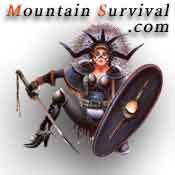

 |
 |
|
Selecting the Proper Boot
|
|
Buying Better Boots
There are different boots for different types of terrain. Follow these 10
essentials to match sole to trail.
1. Ask for the ace. When you walk into an outdoors store, ask to see the best
bootfitter in the shop. If that person is not around, make an appointment to
come back.
2. Measure your dogs. Don't assume you're a size 9 just because that's the size
you've always worn. Your feet grow with time and over the course of long,
heavily laden trips. Get your feet measured for length and width using a
Brannock device, with sliding brackets and size markings. All shoe stores and
most outdoors shops have them, but they're used too infrequently.
3. Don't get hung up on numbers. U.S. sizes vary considerably in their actual
length and volume, and one company's 10 is another's 9. The key is to try a
variety of sizes, then trust your feet to know what fits.
4. Shop after dark. Try on boots at the end of the day, when your feet are
slightly swollen, like they'll be on the trail.
5. Don't rush! Take your time shopping for boots. Budget at least two
consecutive afternoons for shopping and fitting. Try on as many different makes
and models as you can.
6. BYOS. Bring Your Own Socks or (sock combination) to the store so your feet
are wearing what they'll wear on the trail.
7. Wiggle your toes. Once boots are laced, you shouldn't be able to kick your
toes into contact with the very front of the boot. Boots may gain width or
volume once they break in, but they won't ever get any longer. Too-short boots
will bruise your toes and hammer your toenails on long downhills.
8. Go for a walk. Spend some time hiking around the store in any boot you're
considering. The uppers have to warm up for impregnated leathers or stiff
fabrics to mold to your foot, which means pressure points may not become obvious
immediately.
9. Don't "overboot." Choose footwear that matches the majority of your
trips, not the expedition you might take just 1 week a year. If the boot's
heavier and stiffer than you need, you'll needlessly suffer through the
breaking-in and blistering problems of bigger boots.
10. Listen to your feet. Pick the boot that's most comfortable. Stress that one
quality over all others. In the end, only one person will know when you have the
perfect fit, and that's you.
Tip adapted from BACKPACKER.com, March 2001; by Steve Howe